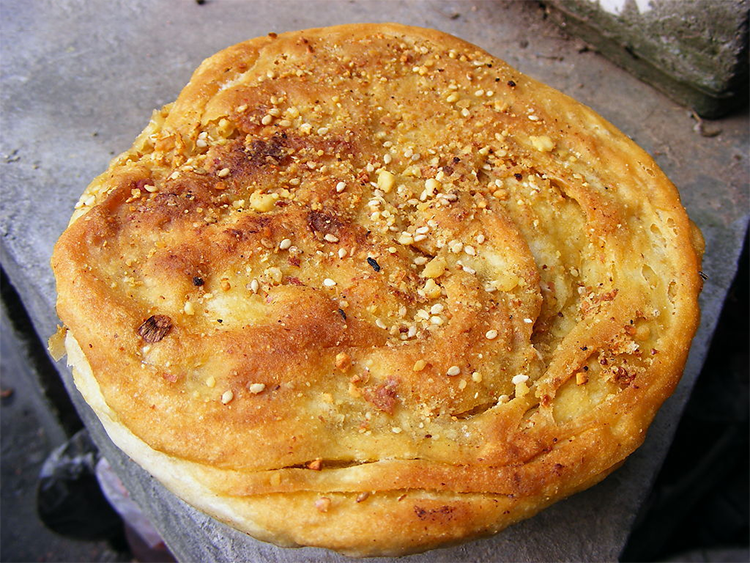Jiaozhuang Shaobing: Zibo’s Must-Try Traditional Chinese Pastry and Golden Breakfast Bite
1. Shandong Jiaozhuang Shaobing: Zibo’s Golden Temptation
On mornings in Boshan District, Zibo, one smell reliably drifts through the lanes—that of freshly baked Jiaozhuang shaobing. These round, sesame-studded golden flatbreads, crisp on the outside and layered-soft inside, are not only a Zibo breakfast staple but a reason many visitors travel here. Made from simple wheat flour, sesame and savory fillings, each bite delivers a satisfying crunch and a warm rush of wheaty, toasted sesame aroma that seems to capture the history and culture of Zibo.
2. Origins and History: From Village Oven to City Emblem
Jiaozhuang shaobing dates back to the late Ming and early Qing dynasties and originated in Jiaozhuang Village in Boshan. Local farmers developed a durable, portable baked bread to take into the fields. Early versions were unfilled. Over time pork, scallions and seasonings were added to boost flavor. Baked against hot clay oven walls, the flatbread often developed charred spots—hence the name Jiaozhuang Shaobing.
The snack’s crispy texture and rich aroma helped it spread beyond the village to become a regional specialty of Zibo and Shandong. After 2000, Jiaozhuang shaobing was listed among Zibo’s intangible cultural heritage items, transitioning from farmhouse ovens to city eateries and evolving into a recognized culinary symbol.

3. Cultural Significance: Zibo’s Taste of Nostalgia
In Zibo, Jiaozhuang shaobing is more than food; it’s a cultural memory. It has witnessed the city’s industrial shifts and carries warm, simple memories of daily life. Many locals recall spending pocket change to buy a piping-hot shaobing at the alley corner as children—blowing on it before taking that first crunchy bite. Today, visitors often hear, “If you haven’t tried Jiaozhuang shaobing, you haven’t truly been to Zibo.” Along with Zibo’s ceramics and glassware, the shaobing is a flavorful calling card for the city.
4. Ingredients and Craft: Traditional Techniques Passed Down
An authentic Jiaozhuang shaobing relies on quality ingredients and skilled making:
– Dough: Shandong wheat flour fermented with old starter for a soft, multilayered interior;
– Filling: Traditional filling uses pork hind leg, fresh scallions and minced ginger, seasoned with soy sauce and salt;
– Surface: Generously coated with local white sesame seeds to amplify aroma when baked;
– Tools: Traditionally baked in clay ovens, though modern electric ovens are also used to lock in moisture.

Key steps:
1. Dough fermentation: two-stage proofing ensures a light, layered crumb;
2. Filling and shaping: meat filling wrapped in dough, rolled into round discs and coated with sesame;
3. Baking: pressed against the oven wall and baked at around 260°C for 5–7 minutes until golden.
As local masters say, “three parts preparation, seven parts baking”: controlling high heat and timing is essential to achieve a crisp, flaky crust and layered interior.
5. Flavor and Texture: A Symphonic Contrast
Jiaozhuang shaobing is memorable for its contrast:
– First impression: a light, audible crunch as the crust breaks and sesame fragrance bursts forth;
– Inner experience: soft, multi-layered dough embraces warm, savory filling—pork umami and scallion freshness mingle beautifully;
– Finish: lingering wheaty and toasted notes with a mildly savory aftertaste that keeps you reaching for more.
Best eaten hot for maximum crispness, the flatbread still holds pleasant chewiness when cooled—making it ideal for travel.
6. How Locals Eat It: Shandong Breakfast Philosophy
In Zibo, shaobing anchors breakfast culture. Popular pairings include:
– Classic combo: torn shaobing dipped into a steaming bowl of Shandong-style grain soup (with beef or lamb), blending textures and temperatures;
– Simple: eaten plain to savor the original baked aroma;
– Creative pairings: served with local tofu pudding or millet porridge to balance richness.
Whether it’s a hurried commuter or a leisurely elder, the image of someone clutching a hot shaobing at dawn is an iconic Zibo street scene.

7. Tasting Tips: How to Enjoy the Most Authentic Bite
– Best time: early morning between 6–9 AM when shaobing are fresh from the oven;
– Recommended spots: old-family shops in Jiaozhuang Village (look for the sign “Jiaozhuang Shaobing Shop”), Boshan markets, and breakfast stalls near People’s Square;
– What to look for: even sesame coverage, golden-brown color with slight charring, and a hollow-sounding tap on the surface;
– Eating tip: eat while hot but be careful—open a small vent first to let steam escape.
Pairing with a local grain soup elevates the experience.
8. Traveler Tips: Bring This Flavor Home
– Where to buy: besides street stalls, you can find vacuum-packed shaobing at Zibo Railway Station and Zhoucun Old Market for easier transport;
– Price guide: traditional meat-filled shaobing typically costs about RMB 2–3 each; gift boxes sell for RMB 20–30;
– Storage: keep at room temperature for 2–3 days; refrigerate to extend up to 5 days. Reheat in a 150°C oven for 5 minutes to restore crispness;
– Cultural experience: some longtime shops allow visitors to watch the baking process or even try pressing a flatbread themselves.
9. Easy Home Recipe: Recreate Zibo Flavor
If you’d like to try at home, here’s a simplified method:
Ingredients:
200g all-purpose flour, 3g yeast, 100g minced pork, chopped scallions, sesame seeds, soy sauce.
Steps:
1. Mix flour with yeast water and proof for 1 hour;
2. Season minced pork with scallions and soy sauce;
3. Divide dough, wrap filling, roll into rounds, moisten and press on sesame;
4. Preheat oven to 220°C and bake 10 minutes until golden.
While it won’t perfectly match a clay-oven shaobing, it makes a delicious approximation.
10. Conclusion: More Than a Snack—Zibo’s Flavor Emblem
The appeal of Jiaozhuang shaobing goes beyond being a tasty treat. It embodies Zibo people’s craftsmanship, history and daily resourcefulness. When you hold a warm, golden shaobing, you taste not only crispness and savory warmth but also a humble, comforting way of life.
Visit Zibo and let the aroma of Jiaozhuang shaobing guide you through its alleys. Remember: only by biting in while it’s hot can you truly say you’ve tasted Zibo.


